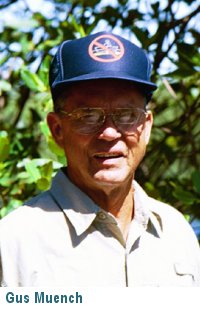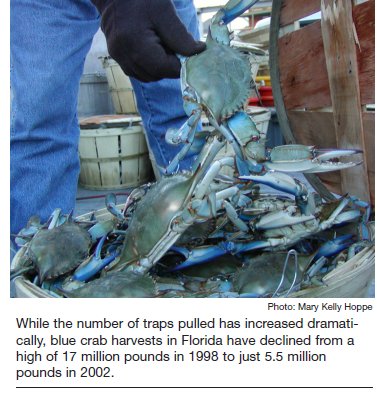Bay Soundings 2004
 Blue crab harvests have dramatically declined over the past several years, from about 17 million pounds in 1998 to 5.5 million pounds in 2002. While harvests increased in 2003, I believe it was directly related to above-average rainfall last year because “Beautiful Swimmers” require brackish water teaming with detritus. These increases may last a couple of years, but are likely to be short-lived when normal rainfall returns.
Blue crab harvests have dramatically declined over the past several years, from about 17 million pounds in 1998 to 5.5 million pounds in 2002. While harvests increased in 2003, I believe it was directly related to above-average rainfall last year because “Beautiful Swimmers” require brackish water teaming with detritus. These increases may last a couple of years, but are likely to be short-lived when normal rainfall returns.
The big question facing Florida still has not been addressed: were diminishing blue crab numbers caused solely by Mother Nature’s varying rainfall amounts, or did they occur because the Florida Fish and Wildlife Conservation Commission does not have a good blue crab management plan in place?
FWC ‘s Blue Crab Advisory Board (BCAB) comprised of 15 commercial fishermen and 1 FWC staff member, has emphatically said “NO” to closed seasons, estuary and river sanctuaries, limits on harvest of female crabs (except egg-bearing crabs), and set a trap limit of 650 traps per fisherman. Compare that structure and management plan to other states:
- Maryland-Virginia has a 16-member Blue Crab Advisory Committee “balanced” with legislators, resource managers, watermen, researchers and environmental groups. That committee already has adopted closed seasons and sanctuaries for blue crabs, but research there indicates an urgent need to conserve the spawning stock for long-term sustainable exploitation and population persistence. It’s possible that Maryland-Virginia may extend their three-month closure to four or five months and take other steps to conserve spawning stock.
- Georgia had a 200-trap limit per blue crab fisherman with no closed season and their resource collapsed. They instituted their first closed season in March 2004, prohibiting all commercial and recreational harvest of adult female blue crabs in Georgia waters, and warned commercial fishermen that further conservation measures may be necessary.
 In my opinion, the FWC floundered when it allowed commercial fishermen to dominate its BCAC. Commercial fishermen can’t be blamed for wanting to dominate the board, or for the diminishing resource, because they are harvesters not overseers. Resource management requires the leadership of researchers and biologists directing the fishing industry on when, where and how to fish. It’s very perplexing to see Florida adopt commercial fishery closed seasons for spiny lobster, stone crab, spotted seatrout, mackerel, groupers, jacks, snappers, but none for blue crabs.
In my opinion, the FWC floundered when it allowed commercial fishermen to dominate its BCAC. Commercial fishermen can’t be blamed for wanting to dominate the board, or for the diminishing resource, because they are harvesters not overseers. Resource management requires the leadership of researchers and biologists directing the fishing industry on when, where and how to fish. It’s very perplexing to see Florida adopt commercial fishery closed seasons for spiny lobster, stone crab, spotted seatrout, mackerel, groupers, jacks, snappers, but none for blue crabs.
So far, FWC has laid no foundation for developing goals and objectives management strategies for a long-term sustainable population of blue crabs. Instead, rules now being discussed in a series of workshops across the state call for development of qualifying criteria for endorsements; establishing a maximum number of traps per endorsement; requiring trap tags; separating the peeler fishery from the hard crab fishery; detailing ways to transfer endorsements with passive reductions; establishing regional short-term closures for trap clean-up; and some gear modifications.
It’s a first step but these rules will not provide for the long-term sustainability we could expect to see with closed harvest during mating season, sanctuaries in areas where crabs spawn and a more reasonable number of traps per endorsement. Additionally, the BCAB did not consider the growing inland waterway competition between hundreds of blue crab trap buoys and Florida’s booming recreational boating population because it would mean moving traps or trimming back on “their” crab trap numbers.
As a commercial fisherman working 400 traps in Tampa Bay and the Little Manatee River since 1976, it’s become clear that my footprint resembles that of a dinosaur and the new kids on the block are recreational fishermen. Congestion between crab pot floats and recreational boaters is a growing major problem but FWC and BCAB ignored the issue.
We need to set aside the upper half of the Little Manatee River as a sanctuary for blue crabs. Along with relieving the competition between commercial fishermen and recreational boaters, it would allow blue crabs the opportunity to spawn and grow during dry seasons, when low-salinity habitats are limited to the upper reaches of rivers. When the rains return, the blue crabs will migrate toward Tampa Bay and we will have an opportunity to capture them.
The blue crab workshop for Tampa Bay was held March 31, but workshops will continue across the state through April prior to the full FWC commission reviewing the recommendations later this summer. Legislators, FWC commissioners and the public should question BCAB proposals. If they’re adopted in place of more stringent requirements, Tampa Bay’s blue crab population and ecosystem balance will be no better tomorrow than it was yesterday.
Gus Muench has been a commercial blue crab fisherman in Ruskin since 1976. FWC commissioners representing the Tampa Bay region are Richard A. “Dick” Corbett of Tampa and David K. Meehan of St. Petersburg. They can be contacted through the Florida Fish and Wildlife Conservation Commission, 620 South Meridian St., Tallahassee, FL 32399.